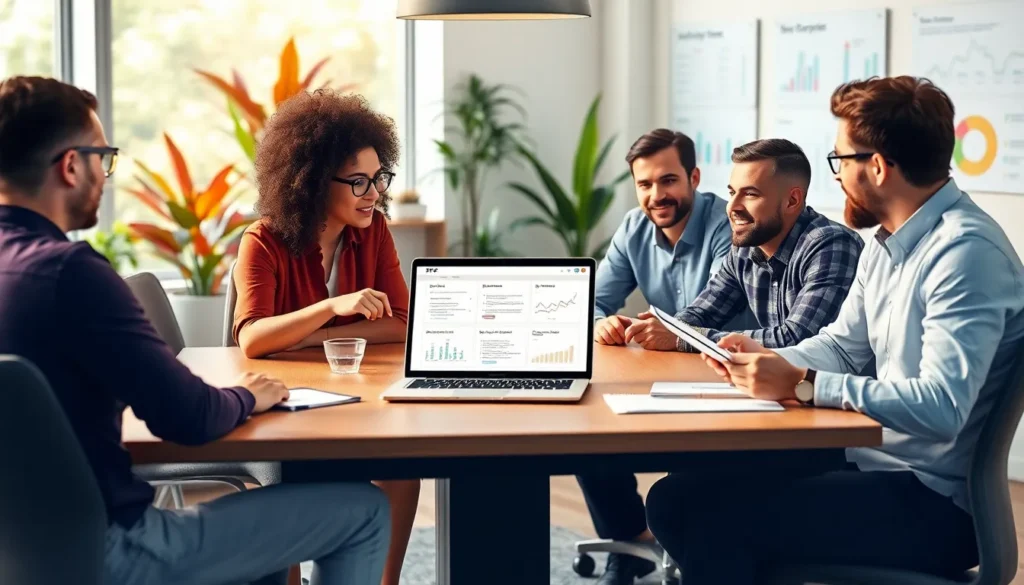Table of Contents
ToggleFlipping an image in Google Docs might seem like a task reserved for graphic designers or tech wizards, but it’s easier than it sounds. Whether you’re trying to create a stunning presentation or just want to give your document a little pizzazz, flipping an image can add that extra flair. Imagine your document as a canvas and you, the Picasso of productivity, ready to turn things upside down—literally!
Understanding Image Manipulation in Google Docs
Image manipulation in Google Docs involves various techniques to alter visual elements for improved presentation. Flipping an image changes its orientation, which can create a fresh perspective on standard visuals. Users often seek to transform images for diverse purposes, like emphasizing specific details or improving overall aesthetic appeal.
To flip an image, select the desired image within the document. Access the “Format options” menu by right-clicking on the image or using the toolbar. Under the “Image options,” locate the “Recolor” section, where you can find options for flipping the image. Options available include “Flip horizontally” and “Flip vertically.”
Common scenarios for image flipping include correcting orientation or achieving symmetry in graphic designs. Flipping images can also assist in creative projects, such as brochures, presentations, and reports. Online resources and video tutorials provide additional guidance for users unfamiliar with image editing tools in Google Docs.
Image manipulation emphasizes the application’s capability to enhance documentation without requiring advanced design skills. Many users appreciate that flipping an image is a straightforward process that adds versatile options to their documents. Engaging with these tools improves the overall quality of presentations and fosters creativity among users. These features ensure that every document can reflect individual style and meet specific communication needs.
How Do I Flip an Image on Google Docs?
Flipping an image in Google Docs is an easy process that anyone can follow. Here’s a detailed look at how to do it effectively.
Step-by-Step Guide
- Select the Image: Click on the image to highlight it within your document.
- Access the Format Options: Right-click on the selected image to open a context menu.
- Choose Flip Options: Navigate to the “Format options” and find the “Rotate” section.
- Select Flip: Click on either “Flip horizontally” or “Flip vertically” to achieve the desired orientation.
- Adjust as Needed: Resize or move the image if it doesn’t fit perfectly after flipping.
This method allows for quick adjustments that enhance visual appeal and maintain document aesthetics.
Common Issues and Solutions
Occasionally, users encounter problems while flipping images. Here are some frequent issues and solutions:
- Image Not Selected: Ensure the image is properly selected before attempting to flip it.
- Format Options Missing: Check that the image is in a compatible format, as unsupported formats may not show the options.
- Flipping Doesn’t Align: If the image doesn’t align after flipping, try adjusting its placement manually.
These solutions help users navigate common challenges and streamline their image editing process in Google Docs.
Alternative Image Editing Tools
Many alternative image editing tools offer similar or enhanced capabilities for flipping images. Users often seek options beyond Google Docs for more complex editing tasks.
Comparison with Other Platforms
Microsoft Word features a user-friendly interface for image manipulation, allowing users to flip images with ease. Canva stands out for its extensive design capabilities, providing multiple options to manipulate images artistically. Adobe Photoshop offers advanced features for professional users; flipping images seamlessly integrates into a wider range of editing functions. GIMP, a free software, also allows easy image flipping along with powerful editing tools suitable for comprehensive design projects. Each platform caters to different user needs, from basic image adjustments to advanced graphic design, ensuring options suitable for every level of expertise.
Tips for Enhancing Your Google Docs Presentation
Utilizing images effectively enhances document impact. Adjusting brightness and contrast can significantly affect visual appeal. Consider using clear, high-resolution images to maintain professionalism.
Incorporating captions provides context for images, guiding viewers through the content. Consistency in image style, such as filters or borders, creates a cohesive look across the presentation.
Experimenting with text wrapping options allows for better integration of images within the text. Applying alignment tools ensures images complement the layout. Using colored shapes or text boxes can help emphasize certain images.
Maintaining an appropriate size prevents images from overwhelming the content. Utilizing the ruler or grid lines can assist in positioning images accurately.
To further enhance presentations, adding transitions or animations can capture audience attention. Exploring Google Slides as an alternative tool for presentations offers additional features.
Lastly, seeking feedback from peers can provide new insights for improvement. Taking advantage of online resources, including tutorials or forums, enhances skills with Google Docs and its features. By applying these tips, users can elevate their Google Docs presentations, ensuring a polished and engaging final product.
Flipping images in Google Docs opens up a world of creative possibilities for enhancing documents and presentations. This simple technique allows users to adjust image orientation and achieve desired aesthetics effortlessly. By following the outlined steps, anyone can manipulate images to suit their needs, whether for personal projects or professional presentations.
Exploring alternative image editing tools can further expand one’s capabilities, offering various features tailored to different skill levels. With the right approach and resources, users can elevate their document design and make a lasting impression. Embracing these techniques not only enriches individual creativity but also enhances the overall effectiveness of visual communication.










